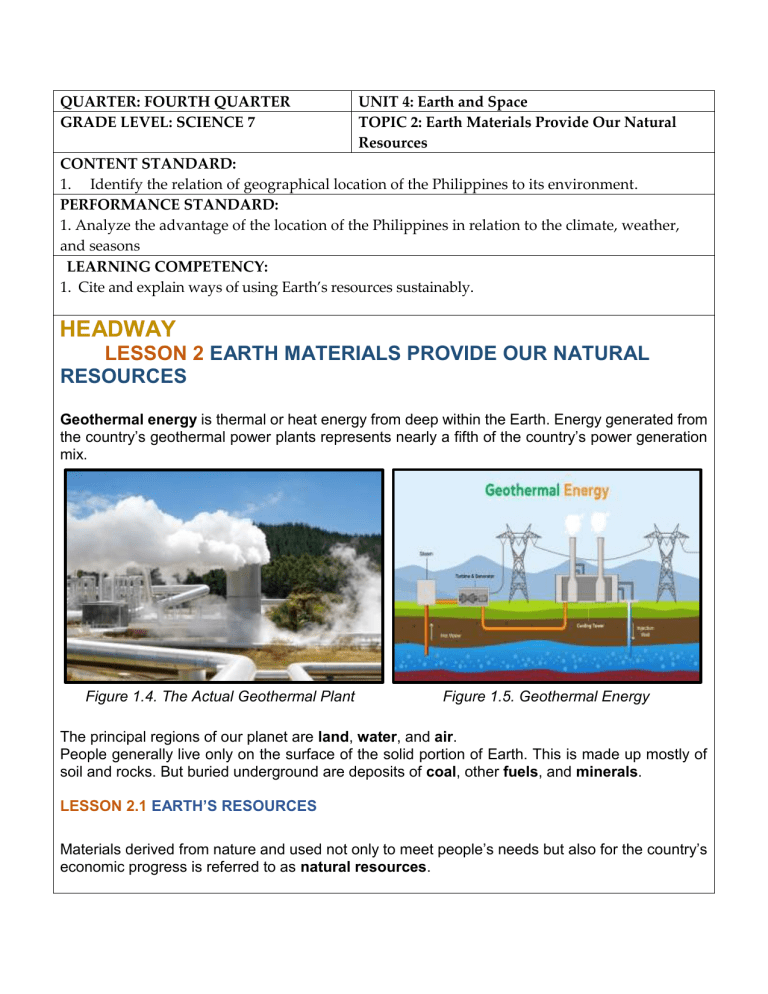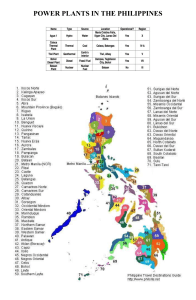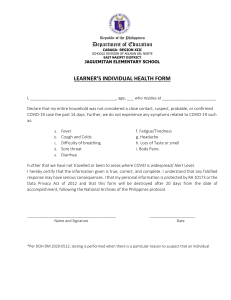
QUARTER: FOURTH QUARTER GRADE LEVEL: SCIENCE 7 UNIT 4: Earth and Space TOPIC 2: Earth Materials Provide Our Natural Resources CONTENT STANDARD: 1. Identify the relation of geographical location of the Philippines to its environment. PERFORMANCE STANDARD: 1. Analyze the advantage of the location of the Philippines in relation to the climate, weather, and seasons LEARNING COMPETENCY: 1. Cite and explain ways of using Earth’s resources sustainably. HEADWAY LESSON 2 EARTH MATERIALS PROVIDE OUR NATURAL RESOURCES Geothermal energy is thermal or heat energy from deep within the Earth. Energy generated from the country’s geothermal power plants represents nearly a fifth of the country’s power generation mix. Figure 1.4. The Actual Geothermal Plant Figure 1.5. Geothermal Energy The principal regions of our planet are land, water, and air. People generally live only on the surface of the solid portion of Earth. This is made up mostly of soil and rocks. But buried underground are deposits of coal, other fuels, and minerals. LESSON 2.1 EARTH’S RESOURCES Materials derived from nature and used not only to meet people’s needs but also for the country’s economic progress is referred to as natural resources. You must have heard nor read the statement “The Philippines is rich in natural resources” many times in the past. But what are these resources? 1. Mineral Resources The country’s metal deposits, which is estimated to be 21.5 billion metric tons, include: Nickel (in Surigao del Norte, Davao, Palawan, Romblon, and Samar); Iron (in Ilocos Norte, Nueva Ecija, Camarines Norte, and Cotabato); and Copper (in Zambales, Batangas, Mindoro, Panay, and Negros). And the nonmetal deposits, estimated to be 19.3 billion metric tons, include: cement, lime, and marble. Figure 1.6. Nickel Figure 1.7. Iron Figure 1.8. Iron Natural resources are materials derived from nature and used not only to meet people's needs but also for the country's economic progress. 2. Forest Resources Philippine forests are mostly dipterocarp forests and mangrove forests, pine stands, and bamboo thickets. They yield timber and other forest products such as bamboo, rattan, ferns, palms, orchids as well as interesting species of birds and some other animals. Figure 1.9. Forest source of foods Figure 1.10. Bamboo material for furniture 3. Agriculture Resources Soil itself is a resource for agriculture. Commercially valuable Philippine crops are coconut, abaca, tobacco, sugarcane, banana, pineapple, rice, and corn. They also include a wide variety of vegetables mostly for local consumption. The pictures above are the products of Philippines. 4. Marine Resources More than two thousand fish species are found in our seas, some of which have good commercial value such as tuna and mackerel. Other marine products are shrimp, squid, crab, and seaweed. Rich fishing grounds are found in Sintangki Island in Sulu, Estancia in Bohol, Lingayen Gulf in Pangasinan, and in the waters of Palawan, Quezon, and Sorsogon. At the same time, freshwater fishing grounds are found in Laguna Lake, Nauan Lake in Mindanao, and numerous fishponds in various parts of the country. The pictures above are the marine resources. Aside from those resources cited above, wind, water, and geothermal spots are resources for power generation. Hydroelectric power is simpler and requires fewer people to operate and maintain as opposed to thermal plants. Refer to Table 1 to see the actual power output produced per region and the potential power output if this renewable energy resources are fully developed. How Can We Protect and Conserve Our Natural Resources? The greatest enemies of a country’s natural resources are: Pollution of land, water, and air; and Overharvesting of resources such as overfishing, overhunting of forest, animals, and irresponsible logging. Hence, to protect and conserve our natural resources people must refrain from doing these two destructive practices. We must also mention that, when you go to college, your choice of a science career can be very helpful in protecting our country’s natural resources. IN FOCUS Fill in the blanks. 1. The surface of the solid portion of Earth is made up mostly of __________ and _________. 2. ________, __________, and _________ are some of our country’s metal deposits. 3. Cement, lime, and marble are _________ deposits found in our country. 4. _________ is the greatest enemy of the country’ resources. 5. Corn, rice, and banana are examples of _________ resources. FINDING WAYS! Earth’s Materials. Water is not the only natural resource that we have to conserve. What other resources should be conserved? List them down. Choose one resource from your list and share to your classmates how you can help conserve this resource. List of other resources. 1. ______________________ 2. ______________________ 3. ______________________ 4. ______________________ 5. ______________________ Chosen Resource. __________________________________________________________________ __________________________________________________________________ __________________________________________________________________ __________________________________________________________________ __________________________________________________________________ __________________________________________________________________ __________________________________________________________________




